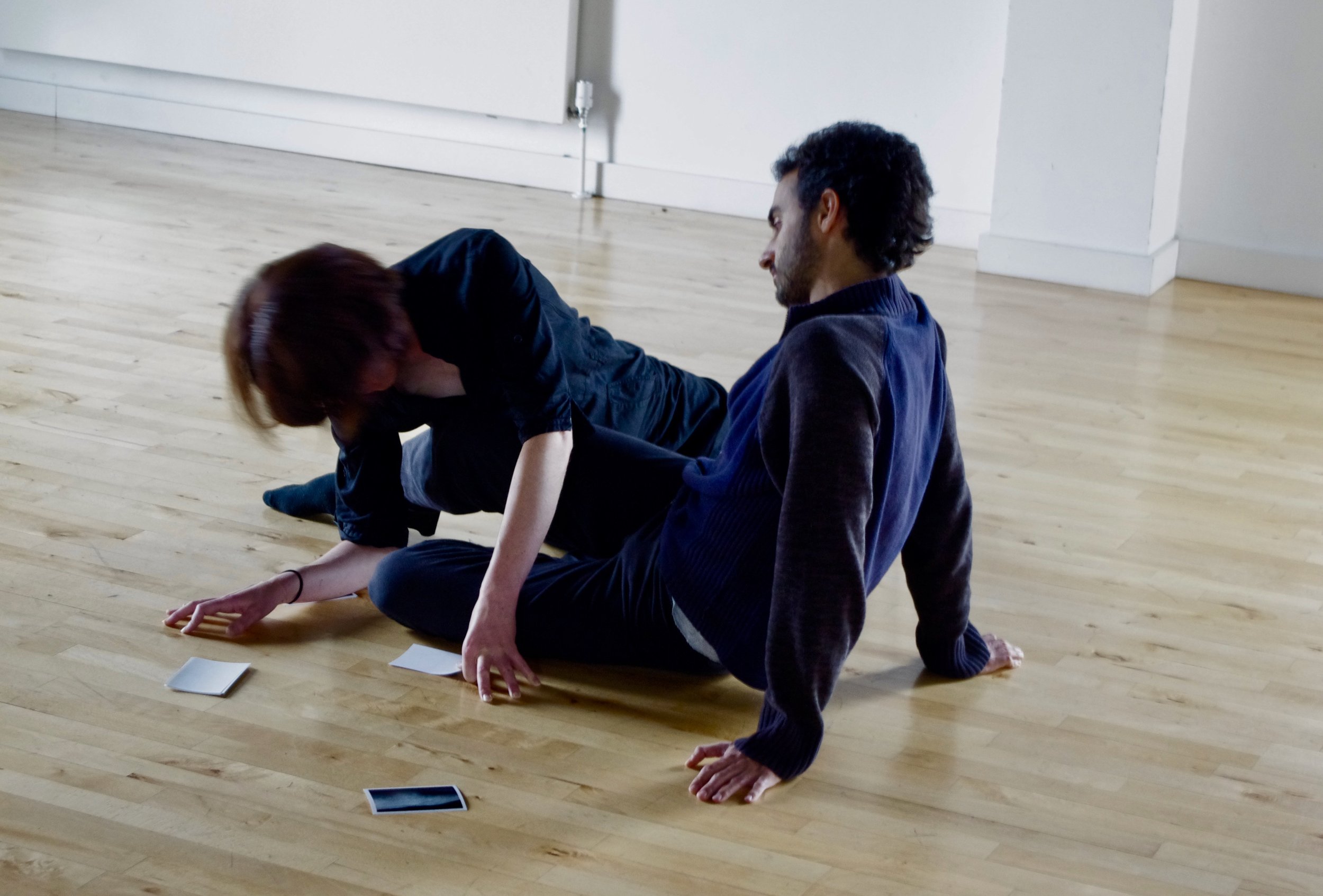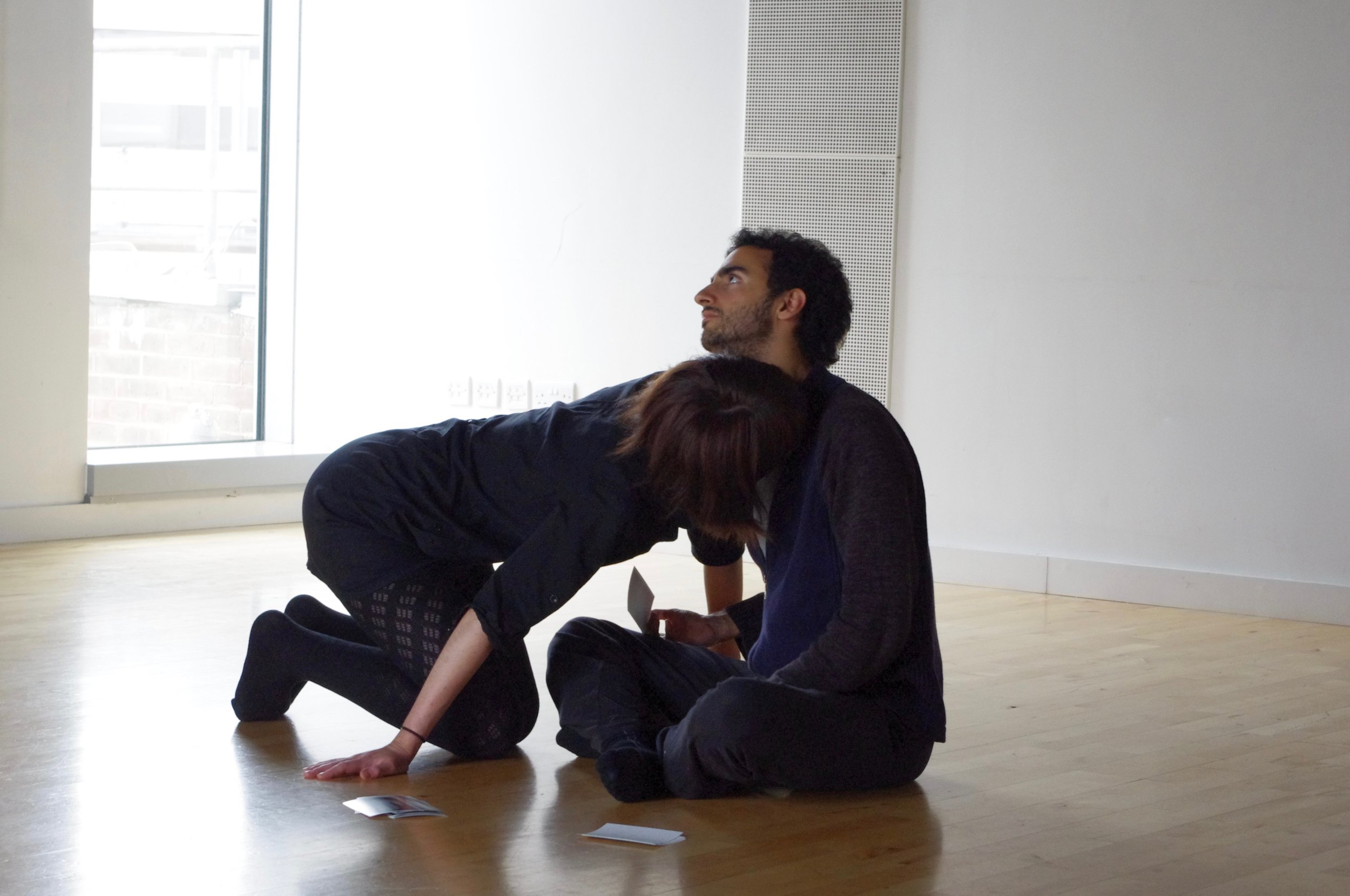




MEANS WITHOUT AN END
“...the topography created in a crumple and torn handkerchief in the depth of a pocket, where metric linear, time and space are collapsed into an unexpected topography of proximities and distances, where entirely different connections are made and events pulled into surprising intimacies and astonishing distances…” Michel Serres
Do we maintain a safe distance from our reality and experiences? Do we seek to frame our feelings, containing them within boundaries that prevent them from spilling beyond what we allow?
Means Without an End is an intimate, one-on-one performance where a single audience member and the performer meet in a dimly lit room, either in a theatre or gallery space. Through a card game and the unique physicality of body contact, the performance explores the creation of an infra-sensual language through reciprocal touch. Much like the tango, the act of touch presupposes a certain demand, a decision, a moment of response-ability.
Process:
In the performance, two participants—the performer (myself) and a member of the audience (or two members of the audience) — play the card game. The performer begins by drawing a card from the deck and turning it over, inviting the audience member to do the same. Once both cards are revealed, the performer initiates a negotiation of physical contact based on the body parts shown (excluding genitals), holding each position briefly. The tension of the piece arises from the unpredictability of the card game—pairings such as ear to knee or forehead to foot—and the resulting physical engagement.
The contact implied by the game is a skin-to-skin encounter. Some audience members may choose to fully engage, removing their clothing to allow complete skin contact, while others may opt for less intimate interactions, such as hand to chin or elbow to ear, without disrobing. Some may even refuse physical contact altogether.
Rather than offering easy answers, the piece encourages reflection. By inviting the audience to take a risk, an immediate sense of intimacy is created, fostering direct, unmediated dialogue.
Conceptual Intention:
In modern society, we often feel compelled to create an armor around ourselves as a means of defense. This impulse to pull back and establish distance can become a central part of our identity, a strategy for feeling secure in the world. But do we maintain a safe distance from our own reality, from our experiences? Do we frame our feelings to ensure they remain contained within boundaries we impose on them? As Michel Serres suggests, we create a topography through the crumples of a handkerchief buried in the pocket—where linear measures of time and space collapse into a surprising landscape of proximity and distance, forging unexpected connections and intimacies.
Means Without an End is a one-to-one performance that combines a card game, text, sound, and body contact to explore the infra-sensual language created through reciprocal touch. The piece examines the structure and possibilities of "touch" by delving into personal and social proximities, questioning the boundaries of the body and the politics of contact improvisation. Through touch, the body improvises at the level of its perceptions, revealing their significance. The performance explores whether this exchange—this encounter—holds meaning.
The emphasis on touch aims to soften perceptions of our boundaries, encouraging awareness of both our fragility and our strength. Like the Tango, which demands a decision and a moment of response-ability, the performance seeks to blur the boundaries between states of allowing and mindful intention.
The goal is to create a shared vulnerability for both the performer and the audience, exploring how the social relationship adjusts (or doesn’t) to accommodate shifting energies and cascading exchanges of power. This heightened awareness deepens our understanding of our individual perceptions, the pain of disconnection, and the longing for communication, offering a mirror to the experiences we encounter daily.
I am interested in the reactions—whether positive or negative—that arise when language is bypassed, and participants engage directly with each other. The skin becomes the medium through which identity is both revealed and constructed.
On Touching:
The surface of the body is a thinking, feeling membrane—it is both a shield and an opening. It protects us but also makes us vulnerable to others. Our bodies resist not only ourselves but each other, knowledge, language, sensing, and ignorance. Touching is a gesture of reaching out, both to others and to ourselves. Each time we touch, we challenge and potentially reshape the body politic, questioning the boundaries of what it means to touch, to be touched, to live together, to live apart, to communicate, and to exclude.
Touch is a moment of response-ability, an act of reaching toward what we do not yet know, of engaging with the unknown. It is the discovery of an infra-sensual language that emerges from our reciprocal touch. The effect of touch cannot be predicted—it remains ungraspable, undefinable.
Touch is not merely the laying of hands. It is the act of reaching toward something or someone, of creating new spaces and times as bodies move. It is not an addition to an already stable body but a demand, a decision that calls forth an instance of response-ability. This multidimensional movement of desire is inherently violent—a violent event that reveals what can be imagined beyond the limits of our experience.
Relation to Tango:
Tango, like touch, involves reaching toward someone or something, creating space and time through the movement of bodies. What fascinates me about Tango is its improvisational nature, which mirrors the politics of touch. Since Tango’s movements are never predetermined, it resists being reduced to a single ideal gesture or contained negotiation. In this sense, Tango becomes a means to explore relationships in the context of corporeal negotiations. It represents a peripheral engagement with the world, one that introduces a different way of interacting with another person. Tango offers the possibility of improvising our encounters, turning us toward others with whom we might not even speak, embodying the space between here and there, between two bodies in exchange.
Means Without an End has been performed at various venues and festivals across the UK and Europe:
2014: Tempting Failures, The Island, Bristol
2013: Dimanche Rouge, La Villette Enchanté Performance Art Festival, Paris
2013: Darnley Gallery, Synesthesia, London
2010: Performance/Workshop during Collision at Central School of Speech and Drama, London
2009: Coachwerks Performance Art Festival, Brighton
2009: BIOS, National Performance Art Festival, Athens
2008: Terra Extremitas by Foolishpeople, Nsdm Werf, Amsterdam
2007: Wimbledon College of Art, London
Type of performance: Interactive one-to-one live performance
Equipment: A deck of 20 cards, each featuring a photograph of different parts of the body: elbow, chin, mouth, knee, ear, hands, foot, chest, lips, neck, and nose (genitals excluded)
Setting: Soft, understated lighting
Sound: Linear cello notes intersected by a clarinet, with a tempo that increases slowly.
Time: Each encounter lasts between 5 minutes or as long as necessary..
Documentation: Photos, memories, anonymous guests' written responses, and music/sound.